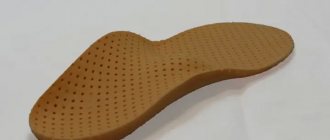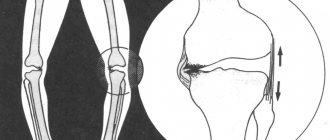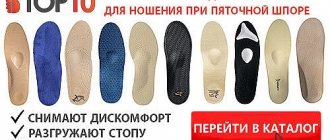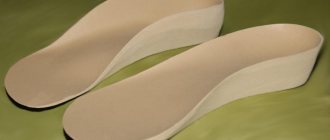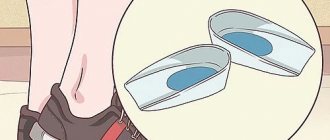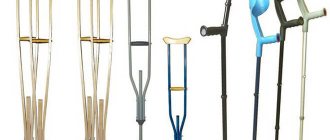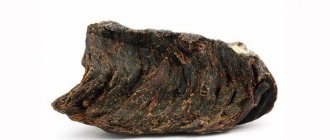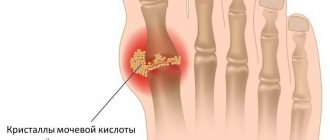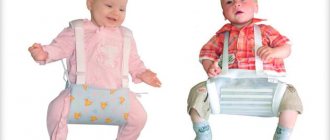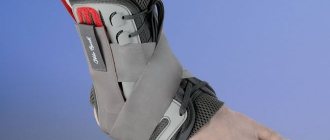The feet, which support the body when walking, are exposed to high loads every day. With age, as well as in connection with the development of pathologies of the musculoskeletal system, deformities, pain, and gait disturbances occur. To combat such problems, orthopedic insoles are used - special devices with anatomical properties. Previously, they were intended for people with disabilities; today, earbuds are actively used by adults and children to take care of their own health.
What are orthopedic insoles?
An orthopedic insole or orthosis, as doctors call it, is a special insert for shoes. Its shape exactly follows all the curves of a healthy foot. The products were created specifically to restore the normal structure of the legs, which can be disrupted due to wearing uncomfortable shoes, poor nutrition, and the development of diseases.
In appearance, orthopedic insoles differ from standard ones in that they have a curved, textured surface. This is where the beneficial effect lies. The insert supports the foot in the correct position and provides full shock absorption when walking. The legs are protected from displacement and other troubles. The shape, design features and materials are aimed at performing several functions:
- normalization of blood circulation;
- protecting muscles from overstrain;
- ensuring the correct position of the legs and joints;
- uniform load distribution;
- reduction of fatigue;
- prevention of the appearance of corns, chafing and calluses.
Thanks to the beneficial effects of insoles, pain is reduced and swelling goes away. Reducing loads and the massage effect prevent the development of arthrosis, osteochondrosis and other diseases of the musculoskeletal system.
Feet - the foundation of the skeleton
The foot, unfortunately, is one of the most underrated parts of the body. After all, it bears some of the heaviest loads every day, because every day we take thousands of steps, and the feet are the only support of the human body. Careless attitude to the choice of shoes, lack of attention to the first signs of deformation and increased loads lead to the fact that the foot is in the wrong position.
If this happens, the entire articular axis running from the ankle to the hip joint is disrupted. Such changes cannot but affect the condition of another stronghold of the musculoskeletal system - the spine. As a result, the risk of its curvature increases sharply, including the development of scoliosis, which will lead to back pain, increased fatigue, and in the most difficult cases – displacement of internal organs and disruption of their functioning. In addition, the curvature of the spine can also negatively affect even the bite. Thus, a lot depends on the condition of the feet. Therefore, they require increased attention to themselves and timely correction of changes that have arisen.
Situations often arise when people begin to treat the consequences of flat feet, turning to a doctor with pain in the knees, lower back, and ankle joint. At the same time, the main reason for their appearance is not taken into account - changes in the state of the only support of the skeleton.
The foot has 3 support points, forming 2 arches: transverse and longitudinal. The first is the arch between the little toe and big toe. The longitudinal arch is the arch between the big toe and the heel. When their size changes, i.e. flattening, they speak of the presence of flat feet. Most often, it is a consequence of muscle atrophy (decreased muscle tone), which in turn can be caused by frequent, prolonged walking on a flat floor barefoot or wearing the wrong shoes.
Since the foot muscles do not function as nature intended, this leads to disruption of the muscular-venous pump, i.e., disruption of blood circulation in the veins of the lower extremities. Normally, the blood descends down to the feet, nourishing their tissues, but to rise up it requires an additional push, which provides muscle contraction during walking, compressing the veins and pushing the blood higher. If this mechanism is disrupted due to weakening of the muscles, a circulatory disorder occurs accordingly. Over time, this causes the development of edema, fatigue in the legs and varicose veins.
But flat feet are far from the only possible disorder of the foot structure. There are a number of other diseases that can lead to similar consequences. But you can prevent their development or eliminate existing ones with the help of orthopedic insoles.
By design
According to their design, insoles are divided into hard - frame and soft - frameless. To figure out which of them are suitable for a particular person, you should know the main characteristics, advantages and disadvantages.
To create rigid orthopedic insoles, special frames made of plastic, graphite or steel are used. Used to support the arch of the foot during prolonged standing or developing flat feet. Suitable for athletes and people who lead an active lifestyle. Pros: absorb moisture well, protect against calluses and corns. Cons: not very convenient to use.
- Comfort insoles TALUS 38K
1,000.00₽
Choose …
- Antibacterial orthopedic insoles Talus 92
1,300.00₽
Choose …
- Orthopedic insoles with unloading elements “Concept-Antishock” TALUS 69
1,700.00₽
Choose …
The advantages of soft orthopedic insoles include unloading the foot, uniform distribution of the load, eliminating discomfort, protecting tendons and ligaments. The main disadvantage is the lack of enhanced shock absorption, which is provided by hard liners. Used only in cases where there are no violations. Suitable for pregnant women and diabetics.
Frame:
Frameless:
By shape
According to their shape they are divided into longitudinal, transverse and combined. The first types of insoles are designed for people suffering from flat feet. Longitudinal instep supports are used to correct disorders. This is ensured by maintaining the arches of the feet in the correct position. As a result, contact with the surface does not occur with the entire sole, but only in certain areas.
The transverse liners are equipped with two wedges - in the front of the foot and on the heel. Serve to neutralize the longitudinal arch. The higher the degree of flatfoot, the more rigid the instep supports should be.
Combined models are intended for the treatment of flattening of the transverse and longitudinal arches. Inserts are used mainly in closed shoes. To get a positive result, you will have to wear them for a long time. The products help maintain the health of the musculoskeletal system and reduce destructive loads during movement.
The advantages of longitudinal, transverse and combined insoles include effective correction of flat feet. The disadvantages are that they are not suitable for treating advanced forms of foot disease.
It is combined flatfoot that is most common these days. Properly selected orthopedic insoles restore the normal shape of the foot at almost any stage of the disease.
Transverse orthopedic insoles:
Longitudinal orthopedic insoles:
Combined orthopedic insoles:
When to see a doctor
Thus, a consultation with a doctor followed by the production of individual insoles based on the blanks made will be indicated for:
- pain and burning sensation in the feet;
- fatigue in the legs, especially when it occurs after a short period of standing or walking;
- increased fatigue;
- the presence of varicose veins, swelling of the legs;
- the formation of a “bump” on the side of the foot in the area of the metatarsophalangeal joint of the big toe;
- heel spur;
- pain in the forefoot;
- pain in the knee joint, thigh, hip joint or ankle;
- pain and fatigue in the lower back;
- the formation of corns on only one (external or internal) part of the foot;
- rapid wear of shoes on one side;
- signs of X- or O-shaped deformation of the legs.
But even if nothing hurts or otherwise bothers a person, this is not a sign of complete health of the feet. The fact is that all these symptoms are already a consequence of the deformations that have arisen, which appear when they become so pronounced that the body loses the ability to cope with them. Therefore, it is highly recommended to undergo preventive examinations, in particular diagnostics of the condition of the feet. This will allow you to accurately determine whether there are deviations from the norm and the risks of their development, which will allow you to start using orthopedic insoles at the earliest stages and avoid the appearance of symptoms that reduce the quality of life.
Expert Opinion of a Doctor
Often, people consult a doctor when they are already concerned about obvious signs of abnormalities in the condition of their feet - for example, pain or significant discomfort when walking. This means that the deformation process has already started quite a long time ago. To prevent this situation, it is recommended to periodically use orthotics for preventive purposes.
Orthopedic insoles
Experience:
Ask a Question
To size
Full-size models replace standard insoles and are suitable for any shoe. Pros: used to improve comfort, treat and prevent various foot diseases. Cons: not suitable for open shoes and sandals.
Half insoles are small products whose action is aimed at a specific area of the foot. Pros: suitable for high-heeled shoes where standard orthoses do not fit. They are used to correct feet, reduce stress on the spine, and treat flat feet. Cons: does not affect the entire surface of the feet.
Inserts are small products that are placed under problem areas. Pros: provide comfort when walking. Cons: only affects certain areas.
Heel pads. Universal models of insoles for shoes, placed under the heel. Pros: increase shock absorption, have a preventive effect. Relieves the symptoms of heel spurs, promotes the healing of corns and cracks. Used for rehabilitation after operations and injuries. Cons: do not fit into shoes.
Full size:
Half insoles:
Earbuds:
Heel pads:
Shoes that are absolutely not suitable for hallux valgus
- This is any shoe with an overly soft sole, especially if the sole is high. The foot should not “fall in” when walking, so the base of the shoe should be sufficiently rigid, and the load should be evenly distributed.
- It is also any tight shoes that can cause calluses and abrasions and aggravate the pain when walking.
- Any synthetic shoes that do not “breathe” - the foot in the shoe must be dry.
- Any shoes with excessively low, flat soles (for example, ballet shoes) - in such shoes the load on the heel increases, which only aggravates the flattening of the arch of the foot.
- Slides (flip-flops) and other types of shoes without a heel or a strap that replaces it - the lack of attachment to the heel also provokes an uneven distribution of the load when walking, which leads to excessive fatigue, muscle spasms and the progression of pathology.
Depending on the type of shoe
Special models are created for different seasons of the year. Winter ones are the thickest and can be supplemented with fur. Summer ones are light and invisible, fixed to the sole using an adhesive composition. Insoles for open backless shoes should have a therapeutic and preventive effect. Pros: correct defects, maintain an aesthetic appearance. Cons: not suitable for treating heel spurs.
Sports models have a cup-shaped heel. Advantages: provide shock absorption and protection against microbes. This also includes antibacterial products containing silver ions, activated carbon, and genuine leather. The components protect feet from unpleasant odor, sweat, and fungal infections. Disadvantages: there is a risk of buying a fake.
For closed, dress shoes, as well as high-heeled shoes, thin orthopedic insoles or semi-insoles are ideal. These liners are made from combined materials. The latex base is covered with natural leather.
The half-insole is suitable for open sandals. Pros: thanks to the arch-supporting shape, reliable support for the foot is provided, and the impact load on the spinal column and joints is reduced. An adhesive sticker is attached to the sole, so the products are completely invisible. Cons: do not always fit tightly in shoes.
When choosing insoles for open shoes, you should give preference to colorless products.
Winter:
Summer:
Insoles for open shoes:
Sports:
For closed shoes:
How to choose an instep support?
This question definitely comes to the mind of anyone who has ever thought about the anatomical comfort of their shoes, sneakers, sandals, boots, and so on. Even in ordinary (non-medical) shoes, arch supports are found quite often, and are quite acceptable in quality. The main thing that a person who wants to know how to choose arch supports should remember is the following:
- soft, easily pressed with a finger, sub-liners have a preventive effect, and hard ones have a corrective effect;
- shoes with instep supports must fit exactly (this is especially true for children) so that the beneficial effect of the part falls on the targeted part of the foot without displacement.
Medical indications for the use of orthopedic insoles.
The selection of orthopedic insoles is made on the basis of diagnosed pathologies. The most common ones include:
- Flat feet. The disease is more common than others and mainly affects women. Advanced forms of the disease lead to the development of arthrosis and spinal deformation.
- Clubfoot. A congenital defect in which the feet turn outward or inward.
- Finger deformities. The most common problem is hammertoes; the disease often develops due to regular wearing of tight shoes.
- Heel spur. It can accompany flat feet and is a bony protrusion that is painful when pressing on the heel.
- Diabetic foot. A complication of diabetes mellitus manifests itself in the form of ulcerative-necrotic lesions of the skin, soft tissues, and in advanced cases, bones.
- Calluses. Rough areas of skin caused by increased pressure or friction.
- Corns. Thickened round spots form on the soles, toes or between them.
- Hyperhydrolysis. Increased sweating due to disruption of the sweat glands. Often accompanied by an unpleasant odor.
Foot insoles help get rid of the listed defects or significantly improve the condition of patients’ feet. Used as prescribed by a doctor.
How to choose and wear orthoses
Today, they are categorized by shape, structure, materials used, as well as manufacturing method. Each buyer must completely replace their own with them. That is, take out the old ones if they take up enough space in the shoes and are not presented in the form of a thin film glued on.
If adults are turning to orthotics for their children for the first time, then they are allowed to buy the least inconvenient option during the adaptation period on a bendable base. To get used to it. When wearing socks, you should listen to the baby’s feelings and complaints. Painful manifestations are not excluded here, since the leg has not yet adapted. However, they should not make it impossible to walk.
In general, the decision about what orthopedic insoles should be should be made by a specialist. You can undergo additional diagnostics to clarify the individual specifics of body weight distribution during walking and rest.
Types and features of medicinal products.
All models with therapeutic properties are designed to eliminate certain foot defects. Let's look at the features of different types of orthopedic insoles and why these products are needed:
- Corrective. In addition to liners, they are supplemented with instep supports, pronators, and high sides. They are used to combat hallux valgus, hollow deformities, and the consequences of surgical operations and injuries.
- Unloading. Equipped with recesses for corns, ulcers and other painful areas, pelota. Thanks to the benefits of orthopedic insoles, discomfort is reduced and foot function is improved. Used for the treatment of heel spurs and diabetic feet.
- Arch-supporting. The height of the instep supports for the outer and inner arches depends on the individual characteristics of the feet. Suitable for the treatment of all types of flat feet, relieve pain, increase endurance.
- Arch-forming. They differ in that the height of the liners for the internal arch is almost the same as for the external one. Used for slow formation of bends.
Therapeutic insoles help correct many diseases that affect the feet. The main condition is full compliance with the characteristics of each person. For example, corrective insoles intended for obese people weighing more than 100 kg are made from durable materials - graphite, steel, and special plastic.
Corrective:
Unloading:
Arch supporting:
Arch forming:
Advantages of making custom insoles.
Orthopedic doctors are sure that mass-produced inserts are not suitable for everyone. For most cases, orthoses must be custom-made. Individual models are made from natural materials and complemented with substrates with antibacterial properties. The design assumes the presence of high-quality support for the longitudinal and transverse arches, a shock absorber for the heel, and a rigid instep support.
The best custom orthotic insoles offer the following benefits:
- maintaining the foot in an anatomically correct position;
- improved blood circulation;
- reducing the load on the joints and spine;
- posture correction;
- elimination of discomfort and pain;
- positive impact on the activity of the entire musculoskeletal system.
The only downside is the high cost. But thanks to modern production technologies, finished products fully correspond to the characteristics of each individual person. Bends and places subject to the greatest pressure are taken into account. Specialists take into account the patient’s lifestyle and the types of shoes he wears most often.
The manufacturing process begins with diagnostic measures. The doctor assesses the condition of the feet and makes recommendations. To create insoles, plaster casts of both legs are used, and computer modeling is carried out. Upon receipt of the finished models, fitting is done, as well as the necessary correction.
Benefits and harms
A person’s legs are constantly exposed to physical stress, which, if a number of prerequisites are present, can cause damage to the feet and the entire musculoskeletal system. Often, flat feet that arose in childhood, which were not diagnosed in a timely manner or were not considered necessary to undergo correction, subsequently lead to hallux valgus, the development of arthrosis of the knee and hip joints, and spinal pathologies, including intervertebral hernias and curvatures.
According to statistics, flat feet are diagnosed in 40% of children over 6 years of age.
All these pathologies initially develop almost asymptomatically. But subsequently they can significantly reduce a person’s quality of life, affect the functioning of internal organs and even cause disability. Deformation of the feet leads to changes in the axis of the lower extremities, their curvature, improper distribution of load and other undesirable consequences. This provokes the occurrence of degenerative-dystrophic changes in the joints of the legs, i.e. arthrosis, which, as the disease progresses, is accompanied by constantly increasing pain and limited mobility. The foot itself also suffers; its constituent structures are deformed, which leads to increased fatigue of the legs, the development of pain and other consequences.
Orthopedic insoles can improve the situation by acting on the root cause - disturbances in the anatomical structure of the foot and muscle tone. With their help, they ensure the restoration of the correct supporting surface of the foot, the position of the foot in the shoe, as well as the relaxation of overly tense muscles and toning, on the contrary, of relaxed ones.
As a result, it is possible to quickly restore normal biomechanics of movements and get rid of discomfort in the legs, fatigue and other symptoms that have arisen. In addition, they prevent the formation or reduction of existing corns and calluses, improve blood circulation in the feet and prevent swelling, and increase stability and endurance.
The most effective use of orthopedic insoles is in the early stages of the development of pathological changes. But even in more complex cases, wearing them will bring positive results, although it will require the additional prescription of other methods of treating the diseases that have arisen.
In addition, orthopedic insoles provide an auxiliary shock-absorbing effect, that is, they help soften impacts when walking and performing other types of physical activity, for which the cartilaginous parts of the joints are responsible in the body. This leads to a reduction in the load on them and is a prevention of the early development of degenerative changes in the joints, i.e. the development of arthrosis. This disease causes pain that tends to intensify as pathological changes progress and can ultimately completely deprive a person of the ability to move independently.
As for the use of orthopedic insoles as part of the prevention of the development of diseases of the musculoskeletal system, such a solution is a significant contribution to the longest possible preservation of joint health. In such situations they will help:
- position your feet correctly in shoes;
- avoid the development of flat feet and prevent drooping of the arches of the feet;
- ensure uniform load on all supporting points of the foot;
- reduce the load on the spine and intervertebral discs;
- Avoid the feeling of fatigue and discomfort in the legs after long walking or running.
Children are also advised to use orthopedic insoles, and it is optimal to resort to their help even in the absence of pathological changes in the condition of the feet. In this way, it will be possible to ensure healthy formation of the foot and posture even while wearing shoes that are not orthopedic. This is an effective solution to the problem of choosing shoes, since children often refuse orthopedic models that ensure health in favor of beautiful, but incorrectly designed ones from an orthopedic point of view.
Important selection criteria.
The most pressing problem is how to choose the right orthopedic insoles. The main goal of these products is to reduce the risk of diseases and eliminate signs of pathologies. The choice depends on your goals:
- Prevention. The inserts are suitable for pregnant women whose spine suffers from increased stress. They are also recommended for athletes and people who often have to carry heavy loads due to their type of activity. The models will be a real find for heel lovers.
- Convenience. Insoles are optimal for those with crooked toes, wide feet, high arches, and advanced stages of flat feet. Inserts protect deformed areas and prevent the development of complications.
- Therapy. They are used for many diseases that negatively affect the condition of the feet: heel spurs, rheumatoid arthritis, diabetes. You should first consult with an orthopedist.
You need to choose insoles according to your foot size. Products should fit snugly in shoes so that they do not move during walking. First, suitable inserts are selected, and then boots or shoes are selected.
What to look for when choosing
It is necessary to pay attention to associated skeletal problems. For example, does a person have osteochondrosis or osteoarthritis (Although this is usually not typical for young patients. More likely for teenagers). This must be taken into account when choosing, since diseases have their own recommendations and limitations. In general, softer and springier products are becoming the prescription of doctors. Such variations can even be used in sports shoes. A good quality of such a product is the memory effect due to the materials used here. This functionality is implemented as follows: the trace is crushed in those places where the greatest pressure naturally occurs on it.
How to choose orthopedic insoles for heel spurs
If flat feet are accompanied by additional diseases in the form of inflammation of ligaments, spur-like formations, etc. You should choose the right product more carefully. The frame still needs to be rigid to secure the leg in the correct position. It is recommended to look for a product with a characteristic such as shock absorption capabilities in the rear section. This refers to a rear shock absorber extended along the roll line of the foot.
Cushioning eases stress on joints. Also here, teardrop-shaped depressions are revealed in the area of the heels (high sides appear), allowing you to move comfortably in the presence of a spur.
Such properties also help patients who have undergone manipulation and surgery in the heel bone and ankle. This accessory is recommended for them during the rehabilitation period.
How to choose an orthopedic insole for longitudinal flat feet
It should be understood that problems along the feet can be both external and internal. Often it is the second version that is identified, which is designated as valgus flattening. With it, the leg becomes flat in this particular part and begins to collapse, so support is needed. The most important structural element here is the pelot (otherwise called the instep support). Its height is selected depending on the degree of the detected violation. The required degree of deflection is also determined. A person may need a frame version or a soft one.
Wearing an orthotic with the protrusion under discussion is not contraindicated even if the leg is healthy. But without excesses in its size.
How to choose orthopedic insoles for a child and an adult with transverse flatfoot
This problem means some kind of deformation in the front part of the foot. Here you will need to select a product with an elevation (metatarsal roller) in this part. Flattening also leads to other accompanying changes. The toe area is especially affected. This is where unwanted bumps appear and the thumb often bends towards the rest. In this case, you should select a product that unloads the second and third metatarsophalangeal joints, transferring the support to 1,4 and 5.
It is worth noting that all these measures will not completely correct the problem. It is impossible to cure existing foot diseases in this way. However, this is a good alternative for those suffering from pain for which doctors do not agree on surgical interventions.
How to choose for mixed flat feet
Often there is a combination of the above variations. At the same time, the task of finding a suitable option becomes somewhat more complicated, since various combinations of ailments can be identified. It is worth noting that the variety of markings and materials of the OrthoPanda company implies the solution of diverse problems.
Nuances of choosing orthopedic insoles for children.
Devices for the child must correspond to the individual parameters of the feet. It is worth giving preference to natural materials that allow air to pass freely. Like adult insoles with orthopedic properties, children's models are preventive and therapeutic. Orthoses must exactly match the size of the leg; they cannot be adjusted for growth.
Flat feet or club feet are easier to prevent than to treat. The formation of feet occurs before the age of 5, so doctors advise using orthopedic inserts from a very early age. The main requirements are lightness, reliability, strength. The arch supports should not be felt during movement and should not cause discomfort.
The insole corrects imperfections only if it matches the size of the feet. The inserts need to be changed periodically. This is not due to wear and tear, but to the rapid growth of children’s legs. Products that become small no longer perform their functions fully.
The foot grows fastest in children under 3 years of age. During this time, insoles should be changed approximately once every 3 months. Up to 7 years – once every 8 months. From 8 – once a year.
- Children's corrective orthopedic insoles "Clubfoot" TALUS 24K
Sale Items for sale
750.00₽ 600.00₽
Choose …
- Insoles Children's corrective orthopedic insoles "BABY" Art. 65A
1,500.00₽
Choose …
- Children's orthopedic insoles (high arch) Lum507 “Arch”
800.00₽
Choose …
- Children's orthopedic frame insoles for active recreation Olavi, pair
500.00₽
Add to cart
Service life and care tips.
The duration of use of the devices is individual and depends on the person’s weight, gait characteristics, frequency of wearing, and physical activity. To maintain the functionality of the insoles, it is necessary to provide them with proper care:
- Do not wash the earbuds with running water or machine wash them.
- To remove dirt, simply wipe the surface with a soft cloth soaked in soapy water. Leather models are cleaned with alcohol. Detergents are not used because they contain a large number of harmful components.
- Drying is done daily and after wet cleansing, always in a natural way; products should not be hung on a radiator or placed in direct sunlight.
- If the insoles get wet along with your shoes, do not throw them away. The orthoses are made from waterproof materials, so this will not affect their functionality in any way. After drying, they will be ready for use again.
Hard insoles require careful care following the recommendations given. Damage caused by washing and drying will soon render the devices unusable.
Athletes can wear insoles for up to 2 years, ordinary people - up to 5 years. Gel and plastic products need to be replaced the fastest; they are designed for 6 months of use. Leather ones will last at least a year.
Is it possible to make it yourself?
For those who like to do everything with their own hands, here is a brief step-by-step description of making an instep support based on the insole from old shoes:
- Step on it with your bare foot, mark the point between the first and second toes, and glue a thick pad 1.5 cm in size here.
- To select the correct foot height, place fabric or cotton wool under the arch until you feel support. Secure it with glue and tape.
- Make a pattern for the top piece from cotton fabric and glue the cutout on top of the previously attached fixtures.
- Craftsmen advise stitching the product along the contour with threads.
The resulting homemade product will quickly fail and lose functionality. It is not for nothing that companies have spent years searching for and testing materials that retain their density and shock-absorbing properties for a long time. Therefore, it makes no sense to engage in manufacturing when there is a large assortment on sale.
The use of insoles orthoses is recommended against the background of compliance with the rules of wearing shoes, daily massage, and repeated courses of physical procedures. Only such an impact will help stop the disease.
